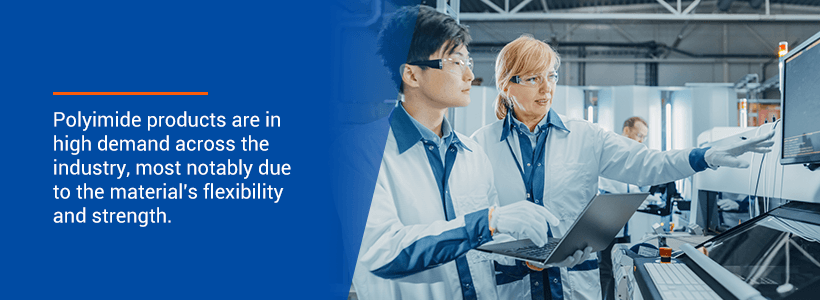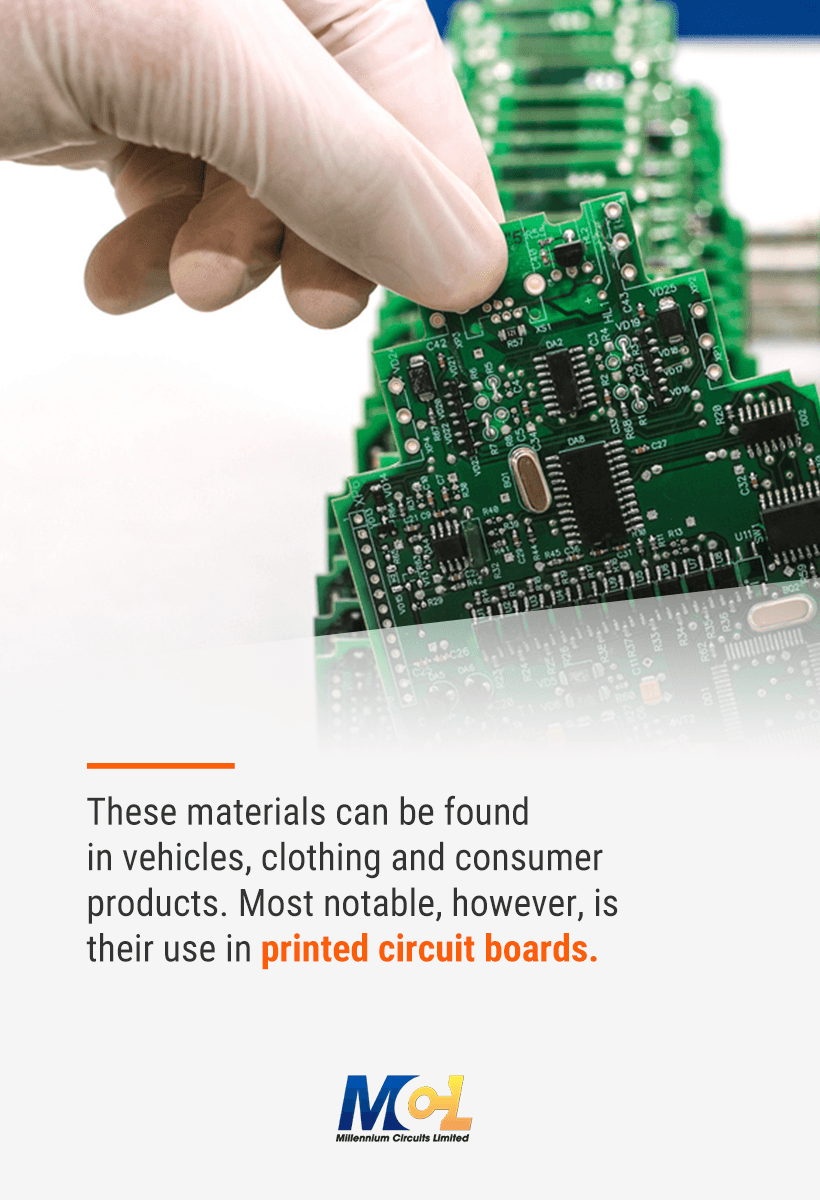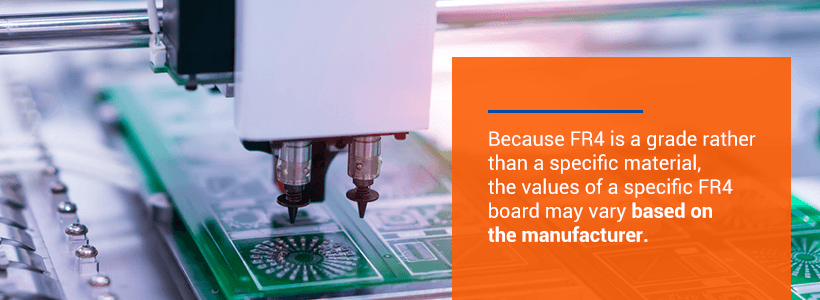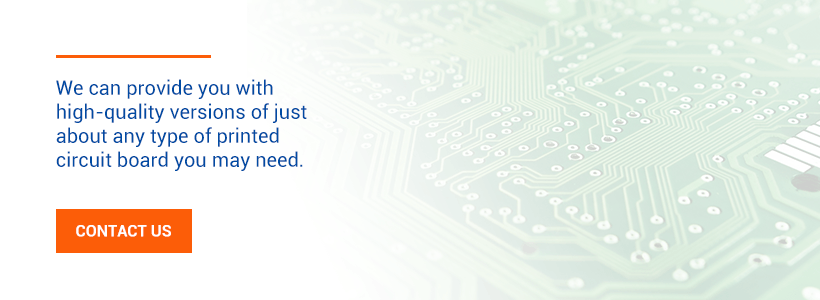
Many companies that use printed circuit boards are content using the standard FR4 material for their boards. FR4 boards are affordable and effective for many applications. However, FR4 boards are not the only type of printed circuit board material available. Some other board types may be more appropriate for certain applications.
One type of board material you may consider is polyimide. There may be some polyimide PCB material properties that will fit well with the board applications for your industry. If you’re just starting to use printed circuit boards, it will be useful to know which material is best before you start ordering them.
If you’re not sure whether or not polyimide/polyimide PCBs may be right for you, read on to learn about the properties of these boards and how they can affect your applications.
What Is Polyimide PCB Material?
Polyimides, also known as polyimides, are polymers consisting of imide monomers. This diverse group of polymers includes various materials, both natural and synthetic. For example, natural polyimides include silk and wool. In manufacturing PCBs, however, the polyimides used for board bases are synthetically mass-produced.
Synthetic polyimides are produced by polymerizing various chemistries that contain imide structures. Most commonly, the process uses bismaleimides and maleic anhydride. The different chemicals and additives used in the process can produce varied results, creating various types of polyimides that offer various advantages. Some examples are listed below:
- Pure Polyimides: Pure Polyimides, also known as 2nd generation polyimides, are produced without brominated flame retardants and other additives. As a result, they are more thermally stable and temperature resistant than many of today’s alternatives.
- 3rd Generation Polyimides: These polyimides include additives that improve flammability resistance, which can help prevent electrical fires. While these types of polyimides tend to be less thermally stable, they offer improved production times due to the lower temperatures and times needed for curing.
- Filled Polyimides: Filled polyimide systems consist of polyimide and a filler. The polyimide produces the thermal resistance and flexibility needed, but the filler helps reduce resin shrinkage, which helps minimize the formation of cracks during the curing and drilling processes.
- Low-Flow Polyimides: These polyimides consist of various resins and flow restrictors that reduce the flexibility of the material.
With time, more polyimide variations are expected to become popular. For example, 4th Generation polyimides are currently under development, which would improve copper foil adhesion and moisture sensitivity, as well as overall stability.
Polyimide products are in high demand across the industry, most notably due to the material’s flexibility and strength. However, this isn’t the only reason that polyimides are favored.
Polyimide PCB Material Properties
Polyimide may be your best choice if your application requires the following:
- Excellent Flexibility: Polyimide material is most commonly used to produce flexible and rigid-flex printed circuit boards because the material is exceptionally flexible.
- Excellent Tensile Strength: Despite its flexibility, polyimide materials are very strong and resistant to warping. This makes it an excellent choice for any application that may require some amount of physical durability.
- Very Thermally Stable: Polyimides are extremely stable at a wide range of temperatures. They can support operation at normally inhospitable temperatures up to 260 degrees Celsius. Additionally, they have good thermal conductivity and can also resist thermal damage during the manufacturing and repair processes.
- Resistant to Chemicals: Polyimides are chemically stable, meaning that they can be exposed to a variety of corrosive chemicals without negative effects. This is crucial in applications that include exposure to such chemicals.
- Highly Durable: On top of being resistant to heat and chemicals, polyimide PCBs are highly resistant to physical stress. They will retain their shape regardless of the physical and thermal conditions applied to them, making them ideal for applications that involve harsh environments and field repairs.
On top of these properties, polyimides have the electrical properties needed to make for a great PCB base material.
What Are the Applications of Polyimide PCB Material?
Polyimides, both natural and synthetic, are used in a wide range of applications. These materials can be found in vehicles, clothing and consumer products. Most notable, however, is their use in printed circuit boards. Specifically, polyimide boards are used to create flexible and rigid-flex PCBs, which have gained popularity within the past several years and are expected to expand in market share between 2017 and 2027.
Polyimide flexible and rigid-flex boards have found a wide range of applications in the PCB industry. Some examples include:
- Computer Electronics: Computer environments, especially laptops, require some amount of flexibility and durability in order to withstand the physical stresses of daily use. In addition, the environments in which computer PCBs operate can become exceptionally hot. Polyimide flexible and rigid-flex PCBs are ideal in these environments, due largely to their flexibility, durability and thermal stability.
- Automotive Electronics: Modern automobiles rely heavily on electronics and commonly use flexible PCBs to handle the vibrations and heat that often occurs within a vehicle.
- Consumer Electronics: Consumer electronics, including smartphones and tablets, are often made with flexible or rigid-flex PCBs due to the stresses of daily use. Flexible PCBs are further being developed for potential future consumer electronics, such as flexible tablets and smartphones.
- Medical Industry Electronics: Many medical applications require some amount of flexibility in the electronics used, especially in the case of implants, prosthetics and imaging technology, which tend to require more movement.
- Military and Aerospace Electronics: Aerospace and military applications tend to prefer polyimide materials for PCBs for their reliability, thermal stability and flexibility. This is both due to the physical stressors involved in these industries as well as the frequent necessity for field repairs, which other materials are less suitable for.
In short, polyimide is highly desirable for a wide range of applications primarily due to its flexibility, strength, durability and thermal capabilities.
What Is FR4 PCB Material?
FR4 is one of the most common substrates for PCBs. However, FR4 doesn’t truly refer to a type of material — instead, it refers to a grade of material. The FR in FR4 stands for “flame resistant” and comes from a grading system developed by the National Electrical Manufacturers Association, or NEMA. This grade indicates that the material is compliant with the UL94V-0 standard.
Though the term FR4 doesn’t truly describe a material, FR4 grade materials are typically laminated fiberglass. These materials are produced by melting raw glass materials and extruding them into filaments of fiber yarn. The fiber yarn is then woven together and coated with resin and a coupling agent to improve adhesion. Once all the materials adhere to one another, the board is laminated with copper foil before going into the PCB manufacturing process.
FR4 grade materials can be divided into subclasses depending on their specific properties. Some examples are described in more detail below:
- Standard: Standard FR4 boards are made of a specific type of fiberglass that has a higher bromine content, which improves the flame-resistant qualities of the material.
- High Glass Transition: Glass transition, or Tg, is the temperature at which a fiberglass becomes unstable. While standard FR4 boards have a relatively low Tg value, high Tg boards are available that offer substantially higher Tg values and improved thermal resistance.
- Halogen-Free: Halogen-Free FR4 boards are made without bromine, which is a halogen that can be toxic to humans. Though bromine benefits the flame-resistant qualities of FR4 boards, halogen-free boards are often necessary for applications that involve human interaction.
Because FR4 is a grade rather than a specific material, the values of a specific FR4 board may vary based on the manufacturer. While they will typically fall within an expected range, the thermal conductivity, flexural strength, water absorption and hardness will likely differ from board to board.
When Should It Be Used?
FR4 is considered to be the standard PCB material for the vast majority of applications. However, it is important to consider all the factors of your application before deciding on one material over another. The following are some of the primary qualities of FR4 to consider before choosing it as a material:
- Strength-To-Weight Ratio:PCBs that require good mechanical strength often use FR4 for its strength-to-weight ratio. Due to the multiple layers and materials involved in FR4 material production, it offers excellent strength.
- Versatility:FR4 can be used as a substrate for a variety of board types, including single-sided, double-sided, and multilayer printed circuit boards.
- Chemically Resistant: FR4 is resistant to a wide variety of chemicals and is resistant to most types of corrosion. Additionally, this material does not absorb water as much as other materials, polyimides included.
- Dimensional Stability: FR4 boards hold their shape very well, making them a great choice for any application with more delicate parts.
- Great Electrical Insulator: FR4 is a well-known electrical insulator and has excellent electrical properties that make it a good choice for many PCB applications.
In addition to the above factors, FR4 boards are very cheap to produce, resulting in lower production costs overall. However, it is important to note that standard FR4 boards offer only limited thermal conductivity — FR4 boards can have trouble dissipating heat and become unstable at higher temperatures.
What Are FR4’s Applications?
Because of its status as default material for engineers, FR4 is used worldwide for a range of different applications. Some of these applications include the following:
- DC Board Applications: The vast majority of DC boards are completed with FR4 due to its low cost, excellent performance and accessibility.
- Low-Frequency Applications: FR4 boards are commonly used in low-frequency applications due to their low cost and comparability to other materials. While FR4 is not ideal for high-frequency applications over 2 GHz, it is a good choice for lower-frequency applications that require functionality without excessive costs.
- Digital Applications: FR4 is a very good option for many digital applications.
These applications can be found across a variety of industries, from the commercial and consumer electronics industries to military and aerospace designs. However, it is important to note that FR4 is not recommended for high-frequency designs, which are becoming increasingly common.
Why Choose Polyimide/Polyimide Over FR4?
When choosing between using Polyimide and FR4, you may be tempted to choose FR4 purely because of the cost and accessibility of this common board material. However, making a choice based on cost is a poor choice, especially when the two materials offer vastly different functional benefits.
If you are considering polyimide and FR4, keep the following benefits of polyimide in mind:
- Flexibility: Flexibility is the primary reason that you would choose a polyimide/polyimide board over an FR4 board. Flexible and rigid-flex circuit boards are typically made out of polyimide and are generally preferred in applications where mobility and frequency of use are a primary concern.
- Good Heat Resistance:If you are planning to use your PCB in a high-heat setting, an FR4 board is probably not the best choice. FR4, while frame resistant, has trouble dissipating heat, resulting in hot spots that can damage the board and surrounding equipment. Polyimide, on the other hand, has excellent operating temperature ratings and thermal conductivity that is twice the value of FR4.
- Resistant to Chemicals: Polyimides offer excellent chemical resistance, especially to hydrocarbons like fuels, oils and greases that are commonly found in military, aerospace and automotive applications. While FR4 offers similar resistance, polyimides offer more complete corrosion resistance over long periods.
- Durable: While FR4 is strong, its rigidity can pose a problem for applications where vibration and heat are a concern. Heat and physical stress reduce the structural integrity of FR4 boards, while polyimide boards are equipped to handle such situations, particularly because of their flexibility and tensile strength.
- Solves Integration Problems: If a PCB needs to be incorporated into a product that doesn’t easily admit components, a rigid circuit board like an FR4 board will not work. Instead, a flexible polyimide PCB can be made to fit into the provided space.
While they are more expensive, polyimide PCBs offer impressive flexibility and functional benefits over traditional FR4 boards. Lightweight, flexible and durable, polyimide PCB boards have the potential to solve many PCB integration and design problems, making them cost-effective in the long run.
Where Can I Get Polyimide/Polyimide PCB’s?
If you’re interested in using polyimide in your designs, Millennium Circuits Limited can help.
Millennium Circuits Limited can provide you with high-quality versions of just about any type of printed circuit board you may need, including polyimide flex circuit boards and FR4 boards, as well as ceramic boards, copper boards and others. For a fast, free online quote for printed circuit boards, fill out our simple contact form — and feel free to call us anytime with questions at 717-558-5975.
If you’re not sure if polyimide flex circuit boards are right for you or you need help determining which PCBs would be best for your business, one of our PCB experts will be happy to help you figure it out.





